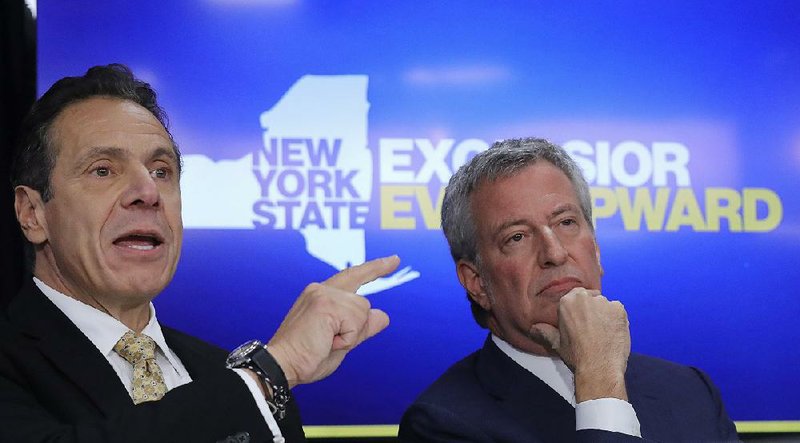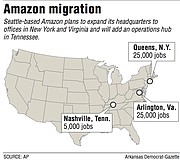SEATTLE -- Amazon laid out its plans for two of the biggest economic development projects in the country Tuesday, announcing that it will put major corporate outposts in New York City and Arlington, Va.
The two locations, in Long Island City in Queens and the area around Crystal City in Arlington, just outside Washington, will eventually house at least 25,000 employees each, the company said in agreements with the local and state governments. Amazon also said the new sites, which it is calling headquarters, would require $5 billion in construction and other investments.
The company also said it will develop a smaller site with 5,000 jobs in Nashville, Tenn., that will focus on operations and logistics.
Amazon, which is based in Seattle, could receive more than $2 billion in tax incentives in New York and Virginia, the company said in its announcement. Up to $1.2 billion of that will come from New York state's Excelsior program, a discretionary tax credit. In Virginia, the company could receive up to $550 million in cash incentives from the state. Both programs are tied to the number of jobs the company creates -- if Amazon's hiring falls short of projections, the incentive payments will be smaller.
"These two locations will allow us to attract world-class talent that will help us to continue inventing for customers for years to come," Jeff Bezos, Amazon's chief executive, said in a statement.
Gov. Andrew M. Cuomo of New York said in a statement that "with Amazon committing to expand its headquarters in Long Island City, New York can proudly say that we have attracted one of the largest, most competitive economic development investments in U.S. history."
The key to luring Amazon to northern Virginia may not have been hundreds of millions in cash incentives but instead plans for a nearby $1 billion graduate campus that will train hundreds of high-tech workers annually.
Part of the state's incentive package for Amazon is an "Innovation Campus" that will be part of Virginia Tech University. It will eventually award 750 graduate degrees a year in computer science and related fields to help fill a shortage of high-tech workers.
Virginia Gov. Ralph Northam said the education component of the incentive package represents a new paradigm in luring economic development.
The announcement capped a frenzied, 14-month competition among cities across the country looking to lure the tech giant for what executives had initially billed as a second headquarters, or HQ2. Many politicians saw it as an opportunity to remake their city or a neighborhood for the tech era.
Critics warned against using public money to help one of the most valuable companies in the world, and of the potential for higher housing costs and traffic problems.
Instead of choosing one site, Amazon decided on two. The decision will let the company tap into the labor markets of New York and Washington and retain bargaining power with two localities for decades.
The company said it would start hiring in New York, Virginia and Tennessee in 2019.
Jay Carney, a senior vice president at Amazon, said the company looked at more than 100 aspects of each location, but "during the process it became clear to us that the overriding criteria was going to be the ability to find and attract talent."
Carney said Bezos did not tour any of the sites, nor did any member of his senior leadership team.
Amazon announced its search in September 2017 for what Bezos said would be a "full equal to our Seattle headquarters." Almost 240 locations submitted bids. They used marketing gimmicks -- Tucson tried to send a giant saguaro cactus -- and formal proposals like training programs and billions in tax incentives.
In January, the online retailer narrowed the list to 20 locations, with places in nine of the 10 largest regions in the country. In the end, Amazon chose to build in two affluent areas with deep benches of high-skilled talent -- and where Amazon already had more corporate employees than anywhere else outside the Bay Area and Seattle. Bezos also owns homes in both new areas.
The two sites Amazon chose have parallels. Both sit just across a river from the heart of an iconic metropolis. Both are also seen as having a lot of unfilled potential: Crystal City is a neighborhood filled with office buildings developed in the 1970s for defense contractors but has had high vacancies after the Pentagon reorganized in the years after the Sept. 11 attacks. And Long Island City is a neighborhood with a mix of new apartment towers, low-rise manufacturing and the country's largest public housing complex.
As the search dragged on, in some places the anticipation turned to antipathy and anxiety, with residents concerned about how their regions could manage a potential housing shortage and congestion that could come with an influx of well-paid workers. Many regions also debated whether one of the largest companies in the world, run by the richest man in the world, needed taxpayer funds.
While Amazon's criteria made clear that attracting a large, educated workforce was paramount in its search, its public competition, and the promise of $5 billion in investments, proved irresistible to the boosterism of elected and development officials around the country. Only a few places, including San Jose, Calif., and San Antonio, publicly declined to throw millions at the giant. Privately, even among the 20 cities on the shortlist, some officials admitted that they were unlikely to land the headquarters.
Little Rock was so certain Amazon wouldn't consider it as a site for its HQ2, it mounted a tongue-in-cheek marketing campaign built around breaking up with the company first.
To hear Jay Chesshir tell it, the strategy worked on several levels.
The value of the city's widely publicized breakup campaign with one of the world's largest retailers was $2.2 million and reached a potential audience of 1.5 billion, according to Cision, a company that measures social media and public relations campaigns, Chesshir, president and chief executive officer of the Greater Little Rock Regional Chamber of Commerce, said Tuesday.
"That obviously has created interest and awareness of the metro Little Rock region that ... we would've never been able to afford to purchase on our own," he said.
The "Love, Little Rock" branding campaign, which coincided with the Amazon marketing campaign, helped spur a marked increase in visits by representatives of companies considering opening up offices or facilities in the region, which Chesshir attributed to the campaigns.
The region has had 34 so-called prospect visits so far in 2018. In the same period last year, the region hosted just 19 "prospect visits."
And Amazon did, it turns out, establish a modest presence in the region, opening earlier this month a local distribution center in a temporary tent-like facility in North Little Rock. It employs about 100 people with a starting wage of $15 per hour, Chesshir said.
"While, unfortunately, we were not exactly what they wanted in terms of the amenities for their HQ2, we're certainly reaping benefits not only from them but also from the campaign itself," he said.
Information for this article was contributed by Karen Weise of The New York Times; by Noel Oman of the Arkansas Democrat-Gazette, by staff members of The Associated Press; and by Michael Sasso of Bloomberg News.
A Section on 11/14/2018

